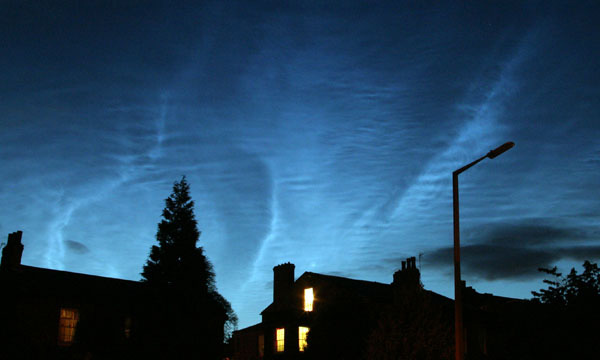
I haven't been spending much time on this diary lately: I've been too busy writing papers! I guess the truly great diarists had lots of spare time... or else they took it as their true profession. The most I get is a relaxed evening now and then: let me use this one to say what I've been up to lately... and what I'll do next.
Since January 24th I've been working with Mike Stay on a paper called Physics, Topology, Logic and Computation: a Rosetta Stone. It's an attempt to help people from different disciplines talk to each other by explaining how category theory provides a general language for systems and processes.
The section on logic, and even more the section on computation, has pushed up against the limits of my competence. I'm learning a lot, but I feel pressured by the deadline — even though Bob Coecke gave me an extension to March 10th. Lisa is going to Brown University next weekend, so I can do nothing but work on this Rosetta Stone paper. That'll be sort of fun. It'll be really nice to be done, and have more time to think about things in a somewhat more relaxed way.
Winter quarter classes finish on March 14th. During the spring break, Lisa and I are flying to the National University of Singapore on the 21st — arriving on the 23rd, and coming back on the 27th. I'll give a talk to the math and physics departments, while she'll speak at the philosophy department.
Spring quarter is a "non-teaching quarter" for Lisa and me. We don't have to teach, since we compressed our courses into the previous two quarters. But, we have to be on campus for all but a month. Lisa plans to spend a month at Fudan University in Shanghai, starting around April 10th. For part of this time — maybe 3 weeks — I plan to visit the CAS-MPG Partner Institute for Computational Biology in Shanghai, invited by Andreas Dress.
Later, around May 6th-13th, I'll visit my pal Bill Schmitt at the math department at George Washington University, and also visit my parents. Later, on May 20th, Alan Weinstein has invited me up to Berkeley to talk about groupoids.
My grad students are making good progress on various projects, enough so they want to spend the spring quarter talking about their work in my seminar, instead of listening to me mouth off. So, both while I'm here and while I'm travelling, the spring seminar will cover these topics:
There's another paper that's been hanging over my head for a long time: Representations of 2-Groups with Laurent Freidel, Aristide Baratin and Derek Wise. Now Derek has sent it back to me... I need to look and see where it stands now.
At times, writing all these papers feels like a rat race. What's the point of churning out so much stuff? More and more I think my real goal in mathematics is not to solve as many problems as possible, or even come up with as many theories as possible. What I really want is to promote a certain spirit, or attitude: clarity, simplicity, a sense of humor. I like to write things that make people happy. But I can't do this well when I'm feeling overworked and stressed-out!
So, I want to slow down. But when I have ideas, it's hard to resist writing about them. And, writing about them always takes a lot of time.
I can't help thinking about this annoying quote by Bertrand Russell:
Abstract work, if one wishes to do it well, must be allowed to destroy one's humanity; one raises a monument which is at the same time a tomb, in which, voluntarily, one slowly inters oneself.
I really don't want this to be true.
I enjoy writing — it's one of my favorite activities. (Hey, I'm doing it now!) So, I don't want to stop, or even write less. I just want to do it without feeling pressured by deadlines or collaborators.
Maybe the best thing would be to work only with Jim Dolan, and write
all the papers myself, at whatever rate I feel like.
March 2, 2008
For some unknown reason,
noctilucent
clouds are
becoming more widespread — clouds made of ice crystals
in the mesopause,
85 kilometers up. They can often be seen glowing at night,
hence their name. Once they were rare, and seen only near the poles.
Now they're more common — and at lower latitudes, too!
Nobody knows why. But, here's one theory. It takes extreme cold for ice crystals to form this high up - that's why noctilucent clouds form mainly near the poles. But, as greenhouse gases keep more heat in the lower atmosphere, less gets out to the upper atmosphere. So, more noctilucent clouds — and at lower latitudes.
In fact, it seems noctilucent clouds were never seen before the Industrial Revolution. Can we be sure of that? If so, it's a big piece of evidence.
On August 4, 2006 I showed you a photo of a noctilucent cloud taken by Lee Montgomerie:
It seems nobody knows what causes noctilucent clouds. Water vapor vastly prefers to condense or form a crystal where there's a pre-existing speck of stuff to cling onto — a "seed" or "nucleator". I've heard it stated quite firmly that most high-altitude ice crystals are seeded by dust from meteors. But I don't know if anyone has actually checked! A quick search actually turns up a paper with a contrary slant:
Abstract: A specially constructed apparatus was used to compare the ice-nucleating properties of dust particles collected above 80 km with those of soil and AgI particles. The dust particles were found to be relatively inactive in ice nucleation when compared with AgI and soil particles of terrestrial origin.You've got to admire someone who actually takes the trouble to collect dust from 80 kilometers up instead of sitting around theorizing. Of course this result doesn't disprove the claim I've heard, since AgI (silver iodide) is supposed to be especially good at nucleating ice crystals — apparently because its crystal structure is similar:
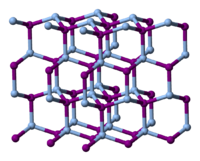
Anyway, the new story is that most snowlflakes are seeded by bacteria!
From the LA Times:
"Bacteria are by far the most active ice nuclei in nature," said Brent C. Christner, an assistant professor of biological sciences at Louisiana State University.I would be very interested to learn whether bacteria survive the process of serving as an ice crystal nucleus. If they do, maybe this is part of their life cycle — it could be a good way to get around! The losers go to Antarctica, but the winners could get a free ticket to almost anywhere.Christner and colleagues sampled snow from Antarctica, France, Montana and Canada's Yukon and found that as much as 85% of the nuclei were bacteria, he said. The bacteria finding was most common in France, followed by Montana and the Yukon, and was even present in Antarctica.
The most common bacteria found were Pseudomonas syringae, which can cause disease in several types of plants including tomatoes and beans.
In the past, scientists have tried to eliminate Pseudomonas, Christner said, but now that it turns out to be a major factor in encouraging snow and rain, he wonders if that is a good idea. Eliminating the bacteria might result in less rain or snow, or it might be replaced by other nuclei such as soot and dust.
On another note, here's an interesting article on corn:
Back in 2002, according to the National Corn Growers Association,
58% of corn went for animal feed, and 10% went to make ethanol.
In 2007 just 46% went for feed and 25% went to make ethanol.
(Other uses include food, exports, seed and various industrial uses.)
March 3, 2008
These are some continents I want to learn more about — some
hypothetical — and their very approximate dates:
On March 2nd I guessed that some bacteria are good nucleators for ice crystals "on purpose", because it helps them spreads around. It turns out the biologist Brent Christner, — whose work I was discussing — agrees. In fact, some bacteria have a protein coat that mimics the structure of ice crystals!
This is just the beginning. Soon they will discover that airborne amoebas can actually steer their snowflakes by shifting their weight, consuming bacteria in an invisible ecosystem. Later, chemical communication systems discovered between bacteria will lead to the realization that clouds are, in a sense, conscious, and able to subtly alter wind currents by taking advantage of the "butterfly effect." These meta-organisms can become malevolent, and seeking feeding material with a unquenchable appetite, spawn tornadoes. (Seeking high concentrations of bacteria and refined sugar products, they are naturally drawn to trailer parks.)And — noctilucent clouds will turn out to be the way bacteria travel between planets!The entire atmosphere will be reinterpreted as an ephemeral biomass. Thunder will be reinterpreted as a kind of mating call.
And just wait until they discover the truth about volcanoes...
Shades of Hoyle's panspermia theory! This is a theory I don't believe, but would like to be true:
A quote:These two scientists did not originally set out to prove that life comes from space. They were astronomers, not biologists. They were trying to identify the contents of interstellar dust by finding something that would match its infrared signature, or extinction spectrum. When they began working on this problem in the early 1960s, the standard theory was that the spectrum could be adequately explained by graphite grains. But an imperfect match between the theoretical and actual spectra, and an implausible account of the formation of the grains pushed Hoyle and Wickramasinghe to search elsewhere. In their work and others', molecules that are more closely related to biology began to enter the picture.In 1968, polycyclic aromatic molecules were detected in interstellar dust. In 1972, convincing evidence that the dust contained porphyrins was obtained. Then in 1974 Wickramasinghe demonstrated that there are complex organic polymers, specifically molecules of "polyformaldehyde" in space. These molecules are closely related to cellulose, which is very abundant in biology. By 1975, Hoyle and Wickramasinghe were convinced that organic polymers were a substantial fraction of the dust. This line of thought was considered wildly speculative at that time. Now however, the idea that organic polymers in space are abundant and may be necessary for life is well accepted. Today we often see stories about things like vinegar among the stars, or "buckyballs" from space as "the seeds of life". To that extent the scientific paradigm for the origin of life on Earth has already shifted.
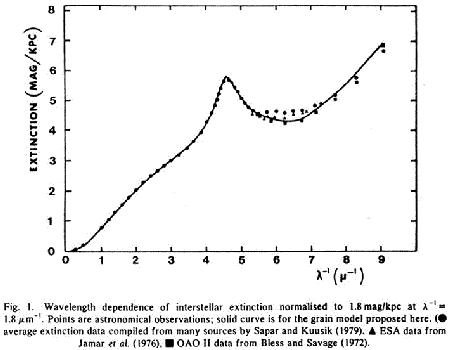
Graph of extinction spectrum of interstellar dust
But Hoyle and Wickramasinghe were not satisfied. In the middle 1970s, they turned their attention to an apparent anomaly in the spectrum. It had a low, broad "knee" centered at about 2.3 wavelengths per micrometer (the slight convexity on the slope at the left side of the graph). This spectral feature could be explained if the grains of dust were of a certain size, and hollow. After trying almost everything else first, in 1979, they looked at the spectrum for bacteria. Dried bacteria refract light as irregular hollow spheres, and their size range is appropriate. The match between the spectrum for dried bacteria (solid line) and the ones from the interstellar grains (dots, triangles and squares) was nearly perfect. Thinking without prejudice, Hoyle and Wickramasinghe concluded the grains probably were dried, frozen bacteria.
When [Wickramasinghe] first made this calculation... he was dumbfounded. After almost twenty years in which he had tried in vain to obtain a theoretical extinction curve closely matching the observations, using theories that permitted a considerable measure of parameter fitting, he now had a theory with no adjustable parameter, a theory which yet gave... excellent results... .This finding was ridiculed at the time, is still ridiculed today, and is definitely not accepted by mainstream science. It has become common to wonder if Fred Hoyle has "gone off the deep end" as several other British scientists have done in their latter years. But in fact, Hoyle spent ten productive years studying the implications of this finding. And Chandra Wickramasinghe is still working on the evidence for life from space. While exploring the vast new scientific territory they found, they have taken some wrong turns and have changed their opinions on some questions. Certain other scientists have roundly criticised them for such "inconststencies" and for sometimes having less than complete corroboration for their findings. Criticism so bitter discourages all pioneering scientific enquiry. Perhaps their work will be honored eventually.
It was sort of nerve-racking work, since there was a deadline that
I really wanted to meet, and it turned out I needed to learn a lot
more about logic and computation to do a decent job. So, it's a
real relief to be done. I'm gonna goof off for little bit,
especially since classes are almost over and I'm making decent progress
on finishing lots of papers. But, I want to keep
working on categories and computation with Mike Stay and also
with Alex Hoffnung... trying to explain things clearly made it
clear there's a lot to be done, especially when it comes to
categorifying the lambda calculus and its quantum version.
March 12, 2008
This morning I was interviewed by Ben Wallace-Wells, who was
commissioned by the New Yorker magazine to write a piece
on Garrett
Lisi. He asked me lots of questions about
the exceptional
group E8, physics, Lisi's theory, and so on. He said
he'd just seen Garrett give a talk at
the U.C. Davis seminar run by my former student
Derek Wise.
March 15, 2008
Classes are over! It's been a relaxing Saturday so far. Last
night and this morning I polished up my course notes on
classical mechanics. Then Lisa
and I worked on the yard, pulling up weeds, transplanting succulents,
and planting a new rose and a cute grey-green plant whose name
I don't know. We also played around with Jeepers.
Jeepers! In the last month this black cat has befriended us:
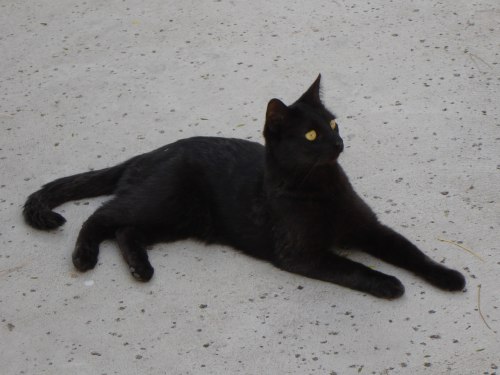
He belongs to our next-door neighbor, but he comes by almost every day. He was shy at first, but now comes running when we call, and rolls playfully on his back as we pet him, pawing at us with claws sheathed. We give him milk but often he's not very hungry. What he really wants is fun and friendship. He's made us happier.
My summer plans are gradually solidifying. From June 16th to 20th I'll go to a workshop on Categorical Groups in Barcelona, organized by Pilar Carrasco. This is part of a big year-long program on homotopy theory and higher categories. I'll also be in Barcelona from June 30th to July 5th to attend the main conference run by this program. In between, say from June 21st to 29th, I'll visit Pilar Carrasco in Granada.
I'll spend most of July and part of August in Paris talking to Paul-André Melliès about categories and computation, with a small side-trip to Portugal. It should be lots of fun, especially since I'll see a bunch of folks I know at Algebraic Topological Methods in Computer Sciences from July 7th to 11th. I hope I can stay in the same apartment near the Jardin du Luxembourg! I should try to arrange that, posthaste.
I asked Carlo Rovelli if he'll be in Paris this summer. He said no — but he gave me an enticing summary of recent developments in loop quantum gravity:
July and August is a rather unlikely period for me to be in Paris. But I would very much like to have the chance of talking with you, physics and else. Here is a telegraphic report of the latest spinfoam beautiful developments that you are missing and will one day regret:If things work out as well as he says, especially regarding the all-important second point, I won't regret having stepped aside from this subject... but I may want to jump back in! It was hard quitting quantum gravity. I'm glad I did, so I'll never regret that. But, I won't feel the need to stay out if I get interested in it again.End of the report.
- First, we have found a modification of Barrett-Crane that matches exactly with loop quantum gravity in 4d, including the area spectrum, and including in the Lorentzian. It basically corrects an obvious "quantization mistake" in deriving Barrett-Crane. So, finally the covariant and canonical approach talk directly to one another.
- Second, I believe the arguments are piling up pointing to the fact that the "many small chunks" intuition is not the right one for approximating processes near flat space: the large-spin limit is the right approximation. These arguments come from uncertainty relations, from cosmology, from the ADM energy operator, and else.
The airport in Singapore was shiny and high-tech, a marked contrast to the dilapidated dirty old airport in Los Angeles. I got an EZ-Link card for the subway system — Lisa already had one. Like the Octopus card in Hong Kong, this lets you pay for the subway by just slapping your wallet or purse on a machine as you enter and leave — no need to take it out! You can also use it to buy all sorts of stuff. Furthermore, all cars in Singapore are equipped with an In-vehicle Unit on the lower right corner of the front windshield. This automatically bills you for driving in congested areas, parking in parking lots, and so on. Needless to say, the government can use all these transactions to track your movements. It doesn't bother me much; I just notice these things.
We took a train to the Park Hotel Orchard on Orchard Road, the main shopping street in Singapore. After a brief nap we explored Arab Street.
Throughout the train station and everywhere in the streets we saw posters for Mas Selamat bin Kastari, alleged leader of the Singapore branch of Jemaah Islamiah, who had been suspected of planning to bomb the airport, and detained without charges in 2006 under the Internal Security Act:
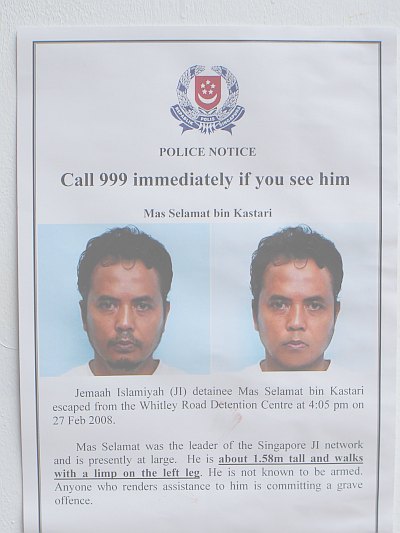
This February 27th, Mas Selamat escaped from a detention center while his family was visiting him. He was being led to a room to meet them when he asked to go to the toilet... and then he mysteriously disappeared!
Needless to say, this was a major loss of face for the Singapore government, which has mounted an energetic but so far utterly fruitless campaign to recapture him. He might be in Malaysia or Indonesia by now. I later heard a summary of rumors surrounding this incident, most notably: 1) it was an inside job and 2) he had been treated so badly during captivity that the government found it necessary to have him disappear. My informant said: "One thing is sure: we'll never know."
It's steamy and hot; beautiful tropical trees line the streets, some covered with epiphytes. Orchard Street is packed with high-end shopping malls, expensive boutiques and fancy hotels.
Lisa and I bought guidebooks at Kinokuniya, a wonderfully large bookstore — part of a chain I'd earlier enjoyed in Sydney. Lisa bought a general guide and I bought a guide to the local cuisine, which is incredibly diverse, including various forms of Chinese, Indian, Malay, Indonesian and Peranakan cuisine, also known as Nonya cuisine. The Perankans are descendants of Chinese who settled around the Strait of Malacca and intermarried with the local Malays.
Later this book came in handy: we had ayam buah
keluak for dinner at a nearby Perankan restaurant, which
however took a while to find. "Ayam" means chicken, and "buah keluak"
means it's cooked with the very distinctive nuts of the kepayang tree,
to make a rich brown sauce. Yum!
March 24, 2008
I gave a talk today — a joint math/physics talk
on higher gauge theory at the National University of Singapore.
Heavy rain in the afternoon. Apparently the rainy season is lasting
longer than usual this year.
March 25, 2008
I got an introduction to the
Nanoscience and Nanotechnology Initiative at NUS. It's got a lot
of people involved all over campus doing lots of fascinating things,
but it's headquartered in a lab in the basement of the physics department.
They noted it was a very small office and I, perhaps tactlessly, joked that
it was good they're doing nanotechnology.
They've got a 10 million dollar (Singapore dollar) grant to work on graphene semiconductors, which have the potential to run much faster than conventional silicon semiconductors. They're also trying to develop new materials for water filtration. Amazingly, despite the rainy climate, Singapore suffers from water shortages! This city-state is so densely packed that there's not enough room for reservoirs. So, they buy water from Malaysia, filter it, sell a bunch back and keep some for themselves.
Lisa gave a talk at the philosophy department of NUS today.
Afterwards we went to dinner with some friends of hers. One asked how
I liked Singapore. I said it was very easy to navigate compared to
Hong Kong and (still more) Shanghai — most everyone speaks
English, it's very clean and orderly, etcetera. He agreed and said some
people call Singapore "Asia Lite".
March 26, 2008
Today Lisa and I mainly hiked around town today — we
took the subway to Little India and poked around a bit:
Lots of small shops selling saris and other clothing, Indian CD and DVDs, groceries, incense, flower necklaces, and the like. Lisa bought a DVD of a couple of movies by the director of Bombay. The woman selling it was probably Tamil. We peeked into an Indian classical music store and saw a guy sitting on the floor repairing a harmonium. Lisa asked if the son of her pal David Kelly had taken tabla lessons there. Yes!
We had lunch in a hawker center: a large open floor at the bottom of a building, packed with booths selling diverse foods and drinks. Hawker centers were originally discouraged by the government of Singapore, being rather dirty places at the time, but then they came to their sense, regulated them, and cleaned them up a bit. They're practically the beating heart of Singapore cuisine — not fine dining, just great eating.
We had an order of satay for lunch, with appam for dessert: a kind of pancake made from fermented rice flour flavored with coconut milk. The fellow who sold it to us asked where we were from. I cautiously said "California", thinking this might deflect a little anti-American sentiment. He smiled, shook my hand, and said how he loved Americans, felt terrible about 9-11, and so on. He said Singapore was a great place. "Do you know the circus — with all the animals lined up, and the ringmaster in the middle?" According to him the different ethnicities in Singapore are kept under control by Lee Kuan Yew.
The shocking pink milk-rosewater drink called bandung was available, along with the complex dessert drink called chendol. However, I was feeling hot and tired, jet lag kicking in, so I had a Coke to chill myself and jolt myself awake with caffeine and sugar. What a waste of an opportunity! I never got around to trying either chendol or bandung, despite their omnipresence.
At 5 pm I had a meeting with Artur Ekert, head of the Centre for Quantum Technologies, which has been set up by the Singapore government as a "centre of excellence" loosely affiliated with NUS. He'd just gotten back from Oxford, where he spends three months a year. He was bursting with enthusiasm, the perfect guy to head a new institute like this. He knew I'd been hanging out at the Perimeter Institute, talking to quantum information people there, and working on n-categories.
I've summarized some of the technical aspects of our conversation in
week262 of This Week's Finds, but
we also talked a bit more broadly about the culture of Singapore.
He said was that Singapore was a fascinating meeting of East and West: the
Greek tradition of argumentation and the more hierarchical Confucian
tradition of meritocracy. I think this is a lovely thought, much more
appealing than mere "Asia Lite". He said he was fascinated by the time
period around 400 BC, simultaneously the heyday of classical Greek and
Chinese philosophy... he said if he could go back in time, it would be
to that time. I cracked up and told him my wife Lisa works precisely on
comparing classical Greek and Chinese philosophy from that time period.
March 27, 2008
Back from Singapore!
March 31, 2008
I talked to James Dolan about modular forms and his (possibly
crazy, possibly great) idea that the modularity theorem is deeply
analogous to quadratic reciprocity. Actually this analogy can be found
in the introduction to Diamond and Shurman's A First Course in
Modular Forms, but Jim is taking it more seriously and trying
to develop it it further, and I'm trying to help out.
For those of you who don't know about this stuff, the modularity theorem is the big, hard, conceptually beautiful result that has Fermat's Last Theorem as a minor corollary. Before it was proved it was called the Taniyama-Shimura-Weil conjecture. Andrew Wiles proved just enough of it to get Fermat's Last Theorem. Other people polished it off.
Jim also pointed out an amazing video of an elephant painting. You've got to watch it!
At night, I hear owl hooting, over and over, for the first time in a long while.
I rejoice that there are owls. Let them do the idiotic and maniacal hooting for men. It is a sound admirably suited to swamps and twilight woods which no day illustrates, suggesting a vast and underdeveloped nature which men have not recognized. They represent the stark twilight and unsatisfied thoughts which all have. - Henry David Thoreau
© 2008 John Baez
baez@math.removethis.ucr.andthis.edu